I have 2 philatelic friends with whom I am in daily email contact. One subject that frequently pops up among us is that of graded stamps—more specifically, the selling of graded stamps, and more specific yet, the selling of graded modern minimal-catalogue-value stamps (MCVs).
While graded and slabbed (encapsulated) coins have been common in coin collecting for several decades, the same practice in philately is still relatively new and is not as fully embraced by collectors. The Professional Stamp Experts (PSE) introduced a grading system for U.S. postage stamps in late 200. While encapsulation of graded stamps was an available service in the past, it is no longer offered, due to low demand.
Not long after PSE started their grading service (as an add-on service to the authentication of a stamp), the Philatelic Foundation (PF) and Philatelic Stamp Authentication and Grading (PSAG) began their own stamp-grading services. While the American Philatelic Society Expertizing Service (APEX) does authenticate stamps, they do not grade them.
When speaking of stamp grades, most collectors will focus on just a single aspect, the centering of the design. However, in the context of these services, the grade of a stamp also takes into account any faults that may be present, such as a crease, a pulled perf, a thin in the gum or the paper, etc. For the purpose of this article, though, I will only address centering.
For many years, grading was the purview of higher-valued stamps, say those cataloguing $100 or more. Sellers and buyers both welcomed it, as it provided an objective and inarguable (for the most part) measure of a stamp’s quality. As Scott Catalogue values are based on faultless stamps with a centering grade of Very Fine (VF), with higher graded stamps commanding commensurately higher market values, a certified graded stamp was a buyer’s assurance that he was getting what he paid for (important, especially, in these days, where many dealers use the terms “Superb” and “Gem” indiscriminately and meaninglessly), and dealers were able to ask for prices closer to Scott Catalogue values.
For example, Scott Nr 234, the 5c Columbian of 1893, has a catalogue value of $150 in Mint Never Hinged (MNH) condition, in the grade of VF. The vast majority of stamps sell for well below Scott Catalogue value, and this stamp is no exception. Shown below are 2 listings currently on HipStamp, for #234 claimed to have VF centering. Their asking prices are about ½ catalogue value.
With a PSE Grading certificate, however, the same stamp commands a much higher price, virtually full catalogue value.
That’s because, the potential buyers for the former 2 stamps can only take the dealer’s not-unbiased word that the stamps are VF, whereas the latter 2 stamps come with a certificate from a recognized service assuring the buyer that the stamps, indeed, have VF centering.
When you get into certified higher grades, the prices can escalate exponentially. Finding the same #234 in PSE-certified XF (extra-fine) condition, the asking price jumps to more than three times Scott Catalogue value.
And for another ½ step up in centering, to XF-S (extra-fine to superb), six or more times catalogue value.
Now, for classic-period stamps, such higher prices for higher graded stamps can be rationalized and justified. Early US stamps were not the products of high-quality precision production methods, especially in the perforation process. Stamps with VF centering are hard enough to find to begin with, and those with XF centering or better are scarcer yet. To get a professional opinion is beneficial to both buyer and seller. I take no issue with the grading and pricing of certified classic-era stamps.
The problem is that the practice of grading and re-pricing stamps to multiples of catalogue value has now infiltrated the low-end stamp market—and by low end I mean those with a minimal catalogue value (MCV) of 25c. And the worst part is, these MCVs are being priced at values many times the multiples that even scarce classic-era stamps bring. I’m talking about stamps that were printed in the tens and hundreds of millions and are readily available, even in the highest grades for catalogue value or less. A case in point is US Scott #935, from 1945, shown below. It had a printing of 135 million, and HipStamp has over 400 listings for examples in MNH condition. It has a nominal catalogue value of 25c, and an actual retail value much less—as low as 1c.
To my eyes, these stamps are virtually identically centered. The one on the left, described only as “Mint Never Hinged,” with the centering left for the customer to decide, is priced at 10c. The other, with a certificate from PSE, certifying that it has Superb centering, is priced at an astronomical 1300 times that stamp—$130.00.
Now, to be clear, the dealer did not pull this value out of his hinter areas. The company that graded the stamp, PSE, also has a supposed price guide on their website, GradingMatters.com, which provides so-called “values” of stamps in each incremental grade from “Very Good – 50” (a euphemism for “lousy”) to “Gem – 100.” It is there that this dealer found his asking price.
I have no idea where PSE gets these values from. I find it highly doubtful (and let me stress, these are merely my personal feelings; I’m not accusing PSE of any nefarious doings) that there are enough fools regularly parting with their money for such stamps to provide a meaningful market value, especially a value 1300 times what is easily available without a certificate.
To compound matters, now there is a cheap software program one can buy (and, no, I will not dignify them by naming them) with which you can determine the centering of your stamps and even print out certificates attesting to such grades (these are termed “e-graded” in their listings).
While the dealers selling such self-certified stamps do not ask the same nose-bleed prices as those dealers with PSE certificates, on a comparative basis, you are actually paying much more because that certificate is not worth the paper it’s printed on. If you ever hope to recoup the price you paid for such a (non)certified stamp, you will end up having to get a PSE certificate anyway. And good luck getting it certified by PSE at the same grade as your pretend certificate states, as PSE’s grade may well be lower, due to unseen faults which the pretend certificate does not even consider.
I fully realize that, in stamp collecting, as in any hobby, or, for that matter, any marketplace, anybody is free to ask whatever price they wish, and anybody can spend whatever amount makes them happy for whatever they desire. I’m all for free enterprise. But these practices have a spill-over effect into the broader stamp market, and other dealers—to wit, the loss of customer trust and the broad brushing of all stamp dealers as crooks, when new collectors and unwitting buyers who fell for this graded-stamp marketing find out how little of their investment they will get back when they try to sell their stamps later.
Stamp dealers struggle enough, already, with collectors who choke upon hearing an offer for their vauable collection of first-day-covers. Imagine, now, when they realize dealers have been charging them up to a thousand times retail for the stamps they have been buying. It doesn’t paint a good picture of the hobby, and as far as I’m concened, this graded modern stamp nonsense can’t disappear soon enough.





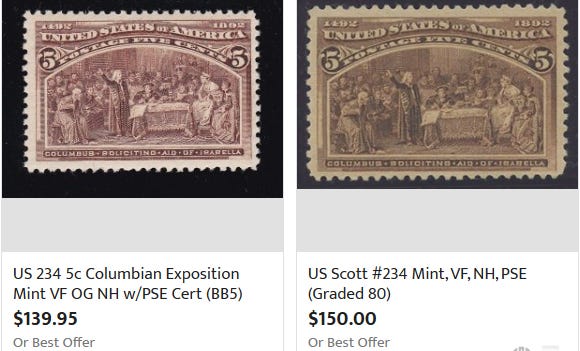
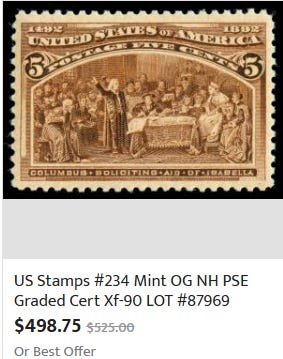
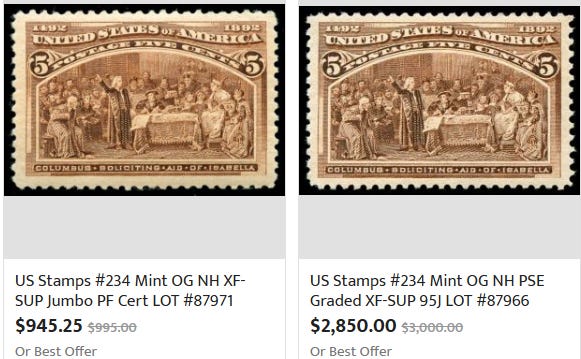
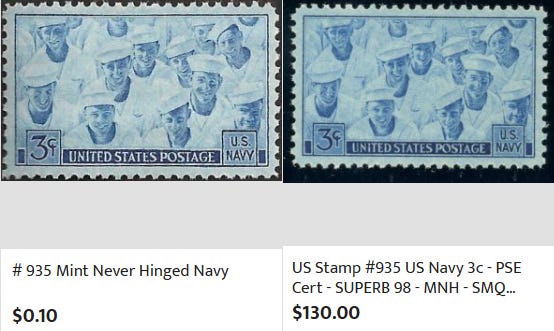
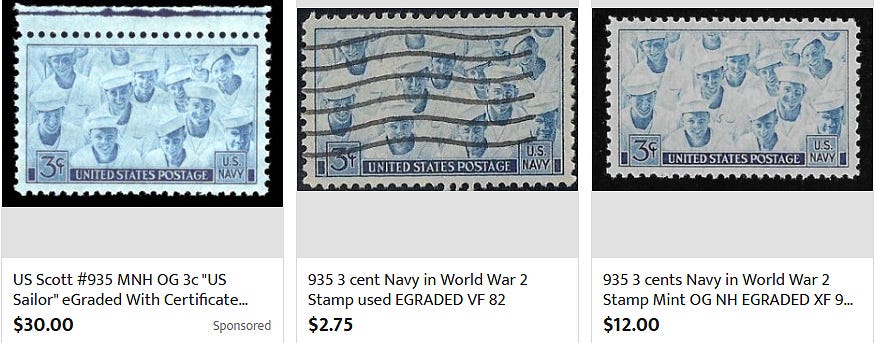
Ted--The situation you describe is worse than I thought. Certainly it is misleading when a "grade" ignores faults.
I avoid this silliness plus the MNH madness by collecting used stamps. I collect stamps, not gum.
Grading at its concomitant price inflation is what drove me away from coin collecting into the gummy arms of stamps. Yes, it's one thing to grade rare coins and stamps but the price increases eventually percolate down to all levels